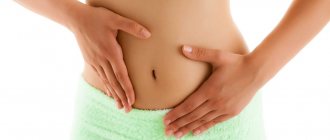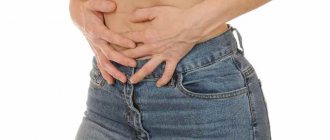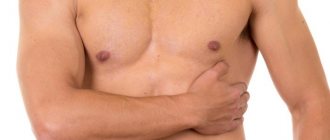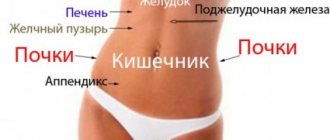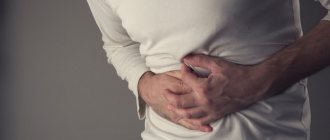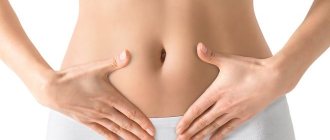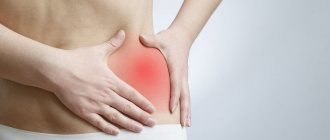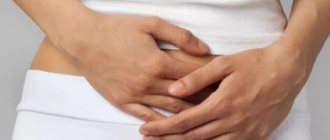Aching pain - what could be the reason
Pain around the navel is likely due to pathology:
- duodenum;
- loops of jejunum and ileum;
- greater omentum;
- stomach (due to its prolapse);
- organs of the urinary and reproductive system.
Pain above the navel is felt due to a pathological process occurring in the stomach or duodenum. Most often this is inflammation, which leads to peptic ulcer. At first, discomfort appears after eating spicy, fried, salty foods, but as the process develops, the pain becomes constant and intense. When perforation of the mucosa occurs, the “acute abdomen” syndrome is formed.
Pain below the navel indicates a problem in the large intestine or in the genitourinary system. Discomfort in this area appears with cystitis, ischemia, irritable bowel syndrome, atherosclerosis, and abdominal aortic aneurysm. Pain near the navel often occurs in women due to cancer of the uterus or ovaries, uterine fibroids, or endometriosis.
As a rule, if the stomach hurts severely in the navel area on the left side, then disturbances in the functioning of the small intestine are detected. Organ dysfunction leads not only to pain and poor digestion, but also due to deterioration of absorption function, extraintestinal manifestations occur, for example, anemia, hypovitaminosis, malarsorption syndrome.
Therefore, if the pain in the navel area is constant or periodic, then you need to consult a doctor to rule out intestinal obstruction, heart attack, jeunitis, umbilical hernia, fermentopathy, oncology, intestinal infection, irritable bowel syndrome.
Aching pain in the abdomen to the left of the navel is more characteristic of chronic inflammatory diseases of the gastrointestinal tract. Frequently recurring gastritis, colitis, sigmoiditis without adequate treatment lead to a chronic course, when pain in the abdomen is of low intensity, but it is constant.
Often patients even come to terms with this pain and get used to it. The pain may increase slightly after eating or going to the toilet. Another possible cause of aching pain in the left side of the abdominal cavity is stretching of the spleen capsule, caused by various reasons (viral or oncological diseases, injuries, iron deficiency anemia).
Note! Aching pain in the left side of the abdomen near the navel may be the first sign of a subcapsular rupture of the spleen.
Reviews
Painful sensations in the left side at the level of the navel can be of a very different nature: aching, pulling, cutting, sharp. This does not always indicate diseases of the digestive system, since this is how myocardial infarction or muscle fiber strain can manifest themselves.
Determining on your own what the cause is, much less taking any measures to eliminate them (drug therapy), is extremely dangerous. In most cases, such pain carries a certain risk to life, so if diagnosed, you should immediately consult a doctor.
What diseases may indicate near-umbilical pain in the left side, what first aid consists of and in what cases it is appropriate, we will find out further.
Classification of pain
Doctors share many different types of pain (more than ten) that can occur to the left of the navel. The table below shows the most common of them.
Pain to the left of the navel varies
Table. Types of pain in the navel by nature.
Nature of pain Possible causes
| Protracted | When lingering pain appears in the navel area, which is of a different nature, the patient is most often diagnosed with peritonitis. The progression of this disease may be indicated by increased pain upon palpation or a change in the patient’s body position. |
| Cramping | The appearance of cramping pain, as a rule, indicates intestinal obstruction. Often the pathology is accompanied by the accumulation of feces and gases in the intestinal cavity. |
| Pricking | Many pathologies of the gastrointestinal tract (GIT), especially in acute form, are accompanied by stabbing pain in the lower abdomen. It is worth noting that this type of pain often occurs with disorders of the genitourinary system, the development of cholecystitis or appendicitis. |
| Strong | One of the most dangerous syndromes is severe pain in the navel area. As a rule, such a symptom accompanies serious diseases, ranging from an umbilical hernia or inflammation of the appendix, and ending with cancer diseases. Severe pain in the navel cannot be ignored, as this can lead to fatal consequences. |
| Pulling | According to statistics, pregnant women most often experience nagging pain in the navel area. As a rule, this is due to deformation of the walls of the abdominal cavity (they stretch). But the appearance of nagging pain may also indicate disturbances in the functioning of the genitourinary system, intestinal obstruction and other health problems. |
| Aching | In most cases, aching pain in the lower abdomen occurs due to flatulence, but there can also be more serious and dangerous causes. For example, the appearance of malignant or benign formations, the development of chronic enteritis or intestinal obstruction can also be accompanied by aching pain. |
Symptoms of flatulence
On a note! You cannot make a diagnosis based only on an analysis of the pain that has arisen, since it is not the main criterion.
Only a correct diagnosis will allow the doctor to make an accurate diagnosis, so if you suspect the development of one or another pathology, do not worry ahead of time, because even severe abdominal pain can be the result of intoxication of the body or a banal disorder of the digestive system.
Causes of abdominal pain
As you have already seen, there are quite a lot of pathologies that can cause pain to the left of the navel.
First of all, this is due to a large number of different systems and internal organs, the disruption of which leads to the appearance of unpleasant sensations in the abdomen.
Pain caused by various diseases, according to location, can be divided into pain in the lower and upper abdomen.
What does pain in the navel indicate?
Hypogastrium
Let's consider the most common diseases that are accompanied by a symptom in the form of pain in the lower left part of the patient's abdomen:
- umbilical hernia. This pathology often causes intestinal obstruction and pain in the abdominal area;
- Endometriosis is a gynecological disease in women, which is accompanied by an increase in endometrial cells. The development of endometriosis is usually indicated by pain in the area of the left ovary; Degrees of endometriosis
- ectopic pregnancy (complication of pregnancy). If a woman of childbearing age suffers from severe pain in the lower abdomen, this most likely indicates a pathology such as an ectopic pregnancy. In parallel with pain, the patient may experience severe dizziness or internal bleeding;
- prolonged constipation can also cause discomfort or pain in the abdomen, but in addition to this symptom, the patient experiences a sharp decrease in weight, bloating occurs and stool passability worsens; Long-term constipation
- intestinal obstruction. In addition to acute abdominal pain, the patient often experiences other symptoms, such as bouts of vomiting or bloating;
- Diverticulitis is a common intestinal disease accompanied by the development of an inflammatory process. Diverticulitis is a common cause of pain in the navel, which is usually localized exclusively to the left side of the patient's abdomen. According to statistics, diverticulitis is most often experienced by older people over 60 years of age.
Possible causes of pain in the navel area
Many of the above diseases pose a serious danger to the body, so it is not recommended to ignore their symptoms, in particular pain to the left of the navel. This can lead to the disease progressing to a severe stage, and treatment becoming more complex, lengthy and financially expensive.
The most common pathologies that cause pain in the upper left abdomen include:
- inflammation of the lungs (pneumonia). The disease is often accompanied by a severe cough, fever and pain in the abdomen; Pneumonia
- pancreatitis or inflammation of the pancreas. The peculiarity of this disease is that abdominal pain may intensify as the disease develops;
- food poisoning. As a rule, when any food is poisoned, the patient’s temperature rises and vomiting occurs. Also, in addition to all the symptoms listed above, pain occurs in the stomach area, that is, in the upper central part of the abdomen; Food poisoning
- malignant formation in the intestine (cancer). A dangerous disease accompanied by symptoms such as general weakness of the body, decreased appetite or its complete loss, sharp fluctuations in the patient’s weight, and prolonged constipation. Over time, pain in the left side of the abdomen may be added to all these signs;
- diarrhea. A patient suffering from diarrhea may experience symptoms such as bowel sounds and cramping abdominal pain. Among all the pathological factors that can cause left-sided abdominal pain, diarrhea is considered the most common;
- volvulus. The disease occurs when the intestine is pulled along its axis or when it turns over. The pathology is accompanied by unpleasant symptoms in the form of bouts of vomiting blood, dizziness and severe pain in the abdominal area. If you do not provide the patient with timely medical care, the disease may become more complicated.
Severe pain above the navel
This is not the entire list of diseases that are accompanied by acute pain in the abdominal area. But regardless of the location of the pain (in the center, right or left side of the abdomen), you must immediately consult a doctor for a diagnostic examination. Timely treatment will help prevent the development of serious complications.
If abdominal pain is caused by a simple indigestion, diarrhea or flatulence, then there is no need to immediately visit the hospital. But, as noted earlier, the cause of painful sensations can be serious pathologies, the appearance of which requires urgent help from a doctor to undergo a medical examination.
Sometimes you need to see a doctor urgently
You should consult a doctor in the following cases:
- sharp pain in the navel area of a pregnant woman;
- loose stool with blood particles;
- decreased blood pressure;
- the occurrence of acute unbearable pain, which is impossible to endure without the use of painkillers;
- frequent vomiting;
- increased body temperature and general fatigue of the patient’s body;
- gradual increase in abdominal pain.
If the pain gradually worsens, consult a doctor
On a note! The appearance of at least one sign from this list should serve as a signal for you to immediately consult a doctor, since in most cases such cases require resuscitation measures or surgical intervention. It is impossible to endure the pain that arises in the hope that soon it will all go away on its own.
Even though people call a doctor when they experience abdominal pain, before he arrives they can experiment with traditional methods to relieve or alleviate the pain. But in most cases, such measures can only make things worse.
First aid for abdominal pain
Before being examined by a doctor, patients are prohibited from:
- take laxatives to empty the intestines;
- give cleansing enemas yourself;
- eat any food;
- Try to relieve pain with painkillers. As an exception, antispasmodics can be taken, but this is provided that the patient has no symptoms of inflammation of the appendix;
- apply warm compresses to the sore spot.
Do not take laxatives until the doctor arrives
It is advisable to avoid any physical activity before going to the clinic and ensure rest. If possible, apply dry ice wrapped in a towel or scarf to your stomach. This should help relieve the pain, albeit temporarily.
Do you still think that healing your stomach and intestines is difficult?
Pain to the left of the navel with this pathology will occur if the obstruction appears on the left side. In addition, the patient may experience vomiting, diarrhea, bloating, excessive gas formation, etc. There are several methods of treating this pathology, but they are all carried out in a hospital setting, so hospitalization of the patient is required.
Judging by the fact that you are now reading these lines, victory in the fight against diseases of the gastrointestinal tract is not yet on your side...
Have you already thought about surgery? This is understandable, because the stomach is a very important organ, and its proper functioning is the key to health and well-being. Frequent abdominal pain, heartburn, bloating, belching, nausea, bowel dysfunction... All these symptoms are familiar to you firsthand.
Symptoms of pathologies that cause pain to the left of the navel
Most of the pathologies have the same manifestations, which means it is impossible to make a diagnosis without examination. And yet, if the patient is able to describe the location of the pain and its nature, and also discovers a connection between its occurrence and food intake or stress, then this will significantly speed up the diagnosis and help get rid of unnecessary medical tests and examinations.
If pain appears at the navel level, the doctor will suspect inflammatory or destructive bowel diseases. Sometimes women, after pregnancy, experience a downward displacement of the stomach, so pain around the navel may appear due to problems with the stomach.
To carry out a differential diagnosis, you will need to collect a complete medical history and undergo laboratory and instrumental tests. If the patient has an “acute abdomen,” then urgent surgical intervention is required.
Difficulty in moving intestinal contents is caused by blockage of the intestinal lumen with a fecal stone, gallstone, tumor, parasites, foreign body, or it is a consequence of compression of the organ from the outside by adhesions, a neoplasm, or intestinal volvulus.
There are complete or partial obstruction, which can be acute, subacute and chronic. The location of the epicenter of pain and the symptoms of the disease will depend on the place where the lumen is blocked.
In case of acute obstruction, for two to fourteen hours, patients experience severe cramping pain in the abdomen, at the peak of which signs of shock appear (pallor, cold sweat, rapid heartbeat, hypotension). With small intestinal obstruction, profuse vomiting occurs, which does not bring relief.
After the first phase of the disease, a period begins that is called “imaginary well-being,” when the pain goes away, but gas and stool retention, flatulence and abdominal asymmetry remain. If the blockage occurs in the small intestine, then fecal retention may not occur; emptying the lower sections is possible after an enema or on its own. 36 hours after the onset of the disease, in the acute course, peritonitis develops.
Chronic intestinal obstruction is rare. As a rule, it is caused by adhesions, hernias, and tumors. With pathology, severe cramping pain occurs, as well as retention of feces and gases, nausea and vomiting.
After hours or two days, the symptoms go away on their own or after drug therapy. Intestinal obstruction requires supervision in the surgical department. Before being examined by a specialist, it is forbidden to do enemas, take painkillers or laxatives.
Severe pain near the navel can also be felt as a result of impaired mesenteric circulation. The cause of the pathological process is blockage of the mesenteric vessels by a thrombus or compression of the artery by a tumor.
When the disease occurs, severe cramping pain appears in the upper abdomen near the navel. When the patient takes a forced knee-elbow position, the intensity decreases slightly. The pain is not relieved even with strong painkillers.
In addition to pain, tachycardia occurs and blood pressure increases. The patient is afraid. The intestine reacts to ischemia with vomiting and diarrhea. After 6–12 hours, after the first symptoms appear, the pain goes away because the nerve endings die as a result of necrosis. Blood is visible in the stool and vomit.
Atherosclerosis or aortoarteritis provokes chronic intestinal ischemia. Pain in this disease is felt in the epigastric region, in the iliac fossa on the right side. Attacks begin 20–40 minutes after eating.
Patients complain of severe cramping pain (which goes away after taking nitroglycerin), gurgling in the abdomen, and stool disturbances. Since the disease progresses, it is necessary to undergo examination as quickly as possible and carry out the necessary therapy.
Intestinal infections, helminthic infestations, excessive alcohol consumption, poor diet, liver disease, metabolic disorders or immunodeficiency conditions can lead to the development of chronic inflammation in the jejunum (jejunitis).
In pathology, due to spasm of the intestinal wall, pain is felt in the area near the navel. Discomfort can also be caused by intestinal distension due to the effects of accumulated gases.
Inflammation of the mesenteric lymph nodes (mesadenitis) also occurs, which is manifested by pain in the left side, to the right or left of the navel.
With the development of the pathological process, gangliolitis is formed and spastic pain is replaced by burning pain. In addition to pain, jejunitis causes severe diarrhea (up to 20 times a day), which can occur immediately after eating.
Symptoms include weakness, changes in blood pressure, and hand tremors. Due to a violation of the intestinal microflora, the stool is foamy and has a strong foul odor. If the changes in the intestine are significant, then the stool has an oily sheen and is similar in consistency to ointment.
Even a child knows: if the stomach hurts to the right of the navel, it could be appendicitis. With age comes knowledge that the gallbladder is also on the right. Why does the stomach hurt to the left of the navel? An unpleasant sensation affecting the left side of the abdomen may indicate the occurrence of serious diseases of the following abdominal organs:
- Descending colon;
- Sigmoid colon;
- Rectum;
- Left ureter;
- Left ovary and fallopian tube (in women).
To understand which ones, you need to understand what kind of pain a person has.
To understand the cause of pain, pay attention to the accompanying symptoms. Each disease has its own symptoms, which allows a preliminary diagnosis to be made before a full examination.
Sigmoiditis
The cause of pain to the left of the navel may be sigmoiditis - inflammation of the sigmoid colon of the large intestine. The disease has two forms: acute and chronic. It can be called:
- Internal causes: infections; Crohn's disease; dysbacteriosis; nonspecific ulcerative colitis; problems with the vessels of the mesentery.
- External causes: poisoning with pesticides; radiation contamination.
Symptoms of sigmoiditis appear:
- In pain of an acute and cutting nature, localized in the left part of the iliac region and radiating to the thigh and lower back.
- In stool disorders (diarrhea or constipation).
- In a false urge to defecate.
- Decreased appetite.
- In general malaise.
- In nervousness and insomnia.
Treatment of sigmoiditis is a strict diet, antibiotics and antispasmodics.
The cause of pain to the left of the navel may lie in Crohn's disease - disorders of the intestinal structure with the formation of intestinal adhesions and fistulas. The disease is chronic. The duration of the acute period can be up to six months, depending on the general condition of the body.
Inflammation gradually leads to a narrowing of the intestinal canal and filling of the intestine with serous fluid around the affected area.
Symptoms of Crohn's disease are divided into two types:
- Extraintestinal signs: feeling of weakness, loss of body weight, constantly elevated body temperature (37-37.5C), damage to joints, blood, kidneys.
- Intestinal signs: sharp stabbing pain, diarrhea mixed with blood and mucus, inflammation of the rectal sphincter.
Until now, doctors have not been able to determine the exact cause of Crohn's disease. Among the reasons influencing the development of the disease are hereditary, infectious and immune-related factors.
The beginning of an exacerbation can be started by:
- Chemical poisoning;
- Gastrointestinal diseases of a viral nature;
- Chronic intestinal infection;
- Stomach or intestinal ulcer;
- Decreased immunity;
- Abdominal injury affecting the sigmoid colon area;
- Postoperative complication;
- Poor nutrition.
Treatment of the initial stages of the disease is medicinal. The doctor may prescribe antagonists for immune system receptors, glucocorticosteroids, and sulfasalazine. If conservative treatment is ineffective, the damaged area is removed surgically. After surgery, the patient must follow a diet and take vitamins.
Diverticulitis
The cause of left-sided pain at the abdominal level can be intestinal diverticulitis, a complication of diverticulosis. It is important to separate these concepts.
The basis of the intestinal walls is made up of smooth muscles, thanks to which peristalsis occurs, propelling the contents into the underlying sections. On the walls of the intestine (usually in the sigmoid colon, located directly in front of the rectum), hernial protrusions - diverticula - can form.
Symptoms of diverticulitis are similar to those of other common diseases. Characteristic signs will help clarify the diagnosis:
- The monotonous nature of pain, localized on the left in the lower abdomen, moving to the left side, intensifies with physical activity, coughing, and laughter.
- The patient can point to a specific point - the center where pain is felt.
- The unpleasant sensations last a long time (up to several days).
- Increased pain upon palpation.
- Alternating diarrhea and constipation.
- Lack of relief after bowel movement.
Possible complications of diverticulitis:
- The formation of a peri-intestinal infiltrate (liquid that permeates the tissue, which upon palpation is felt as a painful tumor-like formation).
- Formation of adhesions causing intestinal obstruction.
- The appearance of fistulas, through which the intestinal contents enter other organs.
- The development of peritonitis - inflammation of the peritoneum.
- In rare cases, diverticulitis may degenerate into a malignant tumor.
Many people have diverticula; only a few develop diverticulitis.
The following can contribute to its development:
- Inflammatory diseases of the large intestine (colitis of various etiologies).
- A small amount of fiber consumed (dietary fiber), which contributes to the development of constipation, increasing pressure in the intestines and causing blockage of diverticula.
- Hereditary factors: a child may have a predisposition to the formation of diverticula, inherited from their ancestors, or even be born with formed diverticula.
- Old age: muscle tone weakens, constipation becomes more frequent, and diverticulum blockage is more likely.
- Helminth infections: worms change the natural intestinal microflora, disrupt the integrity of the mucous membrane, which provokes the appearance of foci of inflammation.
Diagnostic methods
The main importance is given to the first method, that is, blood tests. It is this method that allows us to identify the main disorders in the abdominal organs, as well as exclude the possibility of oncological formations.
Ultrasound provides an excellent opportunity to detect pathological processes. Here the power of the equipment used and the physiology of the patient are of great importance.
Ignoring regularly occurring abdominal pain is harmful to yourself, since these sensations may indicate the development of such serious pathologies in the human body as cancer or various infectious kidney diseases. If the pain near the navel becomes more intense, you should consult a doctor or call an ambulance immediately.
The nature of pain in the abdomen
If intense abdominal pain bothers you for a long time, then this is a symptom of the disease. By the location of the pain, we can tell which organ of the abdominal cavity is not doing its job. Abdominal pain to the left of the navel occurs with indigestion, but can also appear with disorders that require urgent treatment.
Causes of pain
However, when acute attacks of pain occur with a certain frequency, the risk of developing pathologies of internal diseases is high. Self-diagnosis and self-medication are extremely dangerous for health at any age.
In most patients, nagging or aching pain to the left of the navel is evidence of the progression of acute or chronic diseases of the digestive or urinary system.
Pain in progressive diseases tends to intensify with motor or respiratory functions. It is dangerous to leave these conditions unattended.
So, some disorders may be the root cause of pain in the left side to the left of the navel.
The longer the intervals between meals, the more intense the pain. Also, after taking too “heavy” foods, a number of unpleasant symptoms occur.
Food is difficult to digest, causing bloating, flatulence, and weakened immunity.
2 Stomach ulcer and severe abdominal pain at the navel level. It is the terminal stage of acute gastritis, for which there is no treatment. Bacteria multiply rapidly and affect large areas of the mucous membrane.
The danger is created by bleeding ulcerations, which cause severe umbilical pain on the left side of the abdomen. Painful symptoms include bloody inclusions in the stool, turning it dark red or black. The pain increases on an empty stomach and after eating.
Sometimes basal temperature increases slightly and appetite worsens.
3 Gastroduodenitis and pain on the left near the navel. The bacterium Helicobacter Pillory affects the upper parts of the duodenum. Patients note that as the disease progresses, there is severe pain in the left side when inhaling or making sudden movements. The problem can be noticed upon palpation and immediately after eating.
4 Stomach cancer. Malignant tumor in the gastric cavity. There are many reasons for the appearance of a tumor: frequent overeating, abuse of spicy foods, and too hot drinks. When pressing on the epigastric region, pain may appear in the left hypochondrium just below the waist.
5 Pylorospasm pain and cramps in the abdomen on the left or right side. It is characterized by severe spasmodic pain in the stomach, after which the functions of this organ slow down. The blood supply to the gastric walls is disrupted, after which pain appears in the abdomen to the left of the navel. There are complaints of tachycardia. There is a high risk of developing painful shock with a fatal outcome.
Some stomach diseases cannot always be recognized in the early period, when therapy will be most effective. Therefore, it is extremely important to listen to your body in a timely manner.
- The greatest danger to the patient's health is acute pancreatitis. This is an inflammatory process that occurs as a result of exposure to the following factors:
- 1 long-term use of medications;
- 2 frequent consumption of alcoholic beverages that cause severe intoxication;
- 3 hormonal and metabolic disorders;
- 4 tendency to overeat;
- 5 eating disorder;
- 6 abuse of sweet carbonated drinks;
- 7 helminthic infestations;
- 8 injuries of the pelvic organs.
Pancreatitis often becomes chronic. In this case, the gland loses the ability to stablely produce digestive enzymes. This creates a threat of congestion in the stomach and small intestine, followed by intoxication of the entire body. Abdominal pain is felt between the left side and the navel, radiating to the heart and iliac fossa. The inflamed organ is indicated by slightly increased proportions and severe pain. Acute signs of the disease are complemented by:
- 1 chill;
- 2 increase in temperature;
- 3 cold perspiration;
- 4 fever;
- 5 blackout.
1 Ulcerative colitis and unbearable pain on the left side of the abdomen in the center. The intestinal walls become hyperemic and thin. The next stage is bleeding, accompanied by nagging pain to the left of the navel above. They intensify during the act of defecation.
Complaints include severe diarrhea, pain to the left of the navel after eating, weight loss, and general weakness. Gastroenterologists have not yet come to a common opinion as to which factor is the trigger for ulcerative colitis.
Patients suffering from autoimmune pathologies are at risk.
3 If it hurts on the left side - ischemic colitis. It occurs against the background of disorders of the gastrointestinal tract, when an obstacle is created to the transport of nutrients to the lower walls of the large intestine.
Often, the formation of blood clots, aneurysms and varicose veins is observed in the affected areas. The walls of the organ gradually become necrotic, perforations and heavy bleeding occur. That's why it hurts to the left of the navel, closer to the left side of the abdomen.
The pain often creates a feeling of burning waves spreading in different directions.
4 Pseudomembranous colitis. The disease is observed in an acute form, when the internal intestinal walls are ulcerated by pathogenic microorganisms that parasitize the intestinal cavity. Their reproduction is facilitated by a decrease in immunity, provoked by taking medications that suppress the healthy microflora of the mucous membrane. These are the main causes of pain in the left side near the navel.
5 Diverticulitis and pain around the navel. The walls of the large intestine lose elasticity and become deformed, forming elongated valves. They retain food fragments that come under the influence of pathogenic bacteria. Rotting causes acute inflammation when there is pain near the navel on the left side.
6 Acute appendicitis can radiate pain to the left side of the abdomen. Despite the fact that the inflammation occurs on the right, when pressed it hurts on the left side of the abdomen. Along with this, the painful condition includes a feeling of unpleasant distension of the peritoneum, acute colic, high body temperature, difficulty passing stool or severe diarrhea.
1 Enteritis. Occurs when there is inflammation of the small intestinal mucosa. Similar symptoms are observed with gastroenteritis, enterocolitis, gastroenterocolitis. Pain below the navel on the left side. The causes of the disease are often associated with poor nutrition and dysbiosis.
2 Intestinal enzymopathies. Diseases develop at the cellular level. In the body, metabolic processes occur with disturbances.
Pain between the navel and left side becomes noticeable with extensive intoxication.
The root cause of most diseases of the urinary and reproductive system is frequent hypothermia of the pelvis and decreased immunity. Renal failure poses a high risk. This is the answer to the question why the left side hurts at the level of the navel. Pain on the right side should not be excluded if the right kidney is affected, respectively.
- Inflammation in the kidneys occurs with acute symptoms:
- 1 urinary retention;
- 2 false urge to urinate;
- 3 high body temperature;
- 4 stitching pains in the lumbar region.
The spleen is an important organ responsible for neutralizing waste products in the body. Extensive lesions, helminthic infestations, and mechanical injuries lead to the degeneration of the unique cells of this organ into connective tissue.
After which the spleen rapidly loses its functions. In severe cases, perforation of the spleen is diagnosed, accompanied by compressive pain in the umbilical region.
Severe damage to the organ can lead to death from painful shock or excessive blood loss.
An umbilical hernia provokes protrusion of soft tissue into the fatty layer. Pain occurs of varying intensity, increasing with motor functions. The pathology poses a high danger to the patient’s life, since it disrupts the trophism of internal organs.
Diagnostics
- Modern gastroenterologists have the ability to conduct full diagnostics when patients seek help. This:
- 1 ultrasound of the pelvic organs;
- 2 palpation of the abdominal cavity;
- 3 x-ray of the peritoneal organs;
- 4 colonoscopy.
- There are many more diagnostic methods using new medical equipment.
When acute, prolonged pain occurs, doctors are called to the home, trying to minimize motor functions of the entire body.
It is not worth using various drugs to reduce pain - this will neutralize the characteristic signs of the disease, which will complicate the diagnosis. Peritonitis and acute appendicitis require urgent surgical resolution.
Diseases that occur in a fairly predictable form are treated on an outpatient basis. However, self-medication is dangerous even with a chronic course that turns into rare relapses.
Particular attention should be paid to diet. For a long period you will have to exclude spicy, fatty, fried and sweet foods.
Inflammation of the ovary
Major diseases
If a person has pain in the left side, then in 95% of all cases this is the cause of diseases (acute and chronic) of the gastrointestinal tract and excretory system. Acute pain that gets worse with movement or breathing requires immediate medical attention. Let's look at just a few diseases that can cause pain in the left mesogastric region of the abdomen.
Stomach problems
The most common causes of pain in the left side are stomach diseases caused by poor diet, abuse of junk food and sugary carbonated drinks.
The gastric mucosa, whose function is to protect the internal organ from the negative effects of all products entering from the outside, is not able to fully function, which provokes the development of diseases such as:
- Gastritis - occurs as a result of infection of the body by the bacterium Helicobacter pillory, which settles on the mucous membrane, irritating it and causing pain. Unpleasant sensations appear when food does not enter the stomach for a long time, as well as after a large intake of unhealthy (mainly fried and fatty) food. The pain is aching, the peak of which occurs during the digestion of food, after which its intensity decreases. The disease is caused by poor diet, as well as reduced immunity, which is unable to resist infection by Helicobacter pillory.
- Stomach ulcer – develops against the background of active gastritis, for which there is no treatment. Bacteria, increasing in number, occupy ever larger areas of the mucous membrane, which is corroded, resulting in the formation of bloody ulcerations. The damaged integrity of the mucous membrane causes pain, as well as blood in the stool (the stool turns a rich burgundy or black color). The pain is acute, spastic, intensifies after eating. With an exacerbation of the chronic stage of the ulcer, an increase in body temperature, as well as a complete lack of appetite, is possible.
- Gastroduodenitis is a disease in which infection by the bacterium Helicobacter pillory spreads to the upper part of the duodenum. The pain can be either acute or dull, but constant. The stomach hurts with sudden movements, palpation, and also 10-15 minutes after food enters the stomach.
- Stomach cancer - malignant neoplasms in or near the stomach, can be caused by frequent overeating, as well as eating too salty, spicy, hot and fried foods. It is characterized by an enlarged abdomen, acute pain when pressing on the epigastric region, as well as a general deterioration of the condition.
- Pylorospasm - there is a strong spasm of the stomach, in which the organ is not able to fully perform its functions. Natural blood flow is also disrupted, which can cause severe cramping pain on the left side in the navel area. Occurs due to disturbances in the functioning of the cardiovascular system, as well as with the development of cardiogenic shock.
Pancreas problems
The most serious disease of the pancreas is pancreatitis. It is characterized by the presence of an inflammatory process, the cause of which may be the following:
- long-term medication use;
- abuse of alcoholic beverages, which cause severe intoxication of the organ, disrupting its functioning;
- hormonal imbalances and metabolic disorders;
- frequent overeating, especially at night;
- the predominance of sweet carbonated drinks over pure mineral water;
- parasitic infestation;
- abdominal trauma.
Pancreatitis can be chronic, in which the organ does not produce enough enzymes to fully digest food, or it can also have an acute course with severe intoxication and the development of an inflammatory process.
The pain is acute, girdles, and can radiate to the heart and iliac fossa. On palpation, an increase in the organ is noted, as well as increased pain. Body temperature rises, chills, cold sweats, and fever are present.
Colon problems
Diseases of the large intestine appear as a result of a malfunction of the entire gastrointestinal tract, since the organs are closely interconnected with each other, which increases the risk of infection.
Among the most dangerous diseases of the large intestine are:
Ulcerative colitis - the intestinal cavity becomes inflamed and ulcerated, which provokes bleeding, as well as aching, nagging pain, especially during bowel movements. Expressed by such manifestations as:
- frequent diarrhea, followed by prolonged constipation;
- pain in the left side of the umbilical region, which partially or completely disappears after defecation;
- weight loss, deterioration of general condition.
Crohn's disease - the inflammatory process extends not only to the large intestine, but to all intestines as a whole. The pain is diffuse, but most often its focus is in the left side near the navel. The disease occurs due to genetic mutations that occur at the embryonic stage. It cannot be treated; it can only be corrected with supportive drug therapy.
Ischemic colitis - the disease develops against the background of pathologies of the vascular system of the gastrointestinal tract, in which the natural nutrition of the organ is disrupted. Poor blood supply to the colon can be caused by blood clots, aneurysms and varicose veins. The disease is dangerous because at any time the non-elastic walls of large vessels can rupture under pressure, causing large-scale internal bleeding. The pain is localized in the central area of the abdomen, and can also spread in hot waves in different directions. Increased pain occurs after intense physical exertion, as well as during palpation.
Pseudomembranous colitis is a disease in which ulceration of the internal walls of the intestine by microorganisms that live there increases, but their uncontrolled increase transfers them from the group of conditionally pathogenic to pathogenic. This condition is caused by long-term use of antibiotics, which completely destroy the entire intestinal microflora, preventing the immune system from restraining the development of pathogenic microorganisms. It manifests itself as painful sensations on the left side of the central abdominal area, as well as bowel dysfunction (prolonged constipation or diarrhea). A mild degree occurs after a course of antibiotic treatment.
Diverticulitis - the large intestine loses its elasticity, its inner walls bulge, forming membranous sacs. In such formations, food subject to rotting processes can be retained, where the inflammatory process originates. The pain is moderate, mainly when moving: bending or turning the body.
Acute appendicitis - the patient feels a sharp sharp pain, which sometimes affects the left side (usually when the appendix is inflamed, it hurts on the right). It is accompanied by a feeling of fullness from the inside, spasms and colic. The pain decreases with the passage of gases, but becomes more active with any movements, sudden sighs and any tension in the abdominal cavity.
Pain in men
Pain in the left side of the abdomen in men can occur for various reasons. This:
- Inflammation of the testicles;
- The appearance of a hernia;
- Cyst development.
These pathologies cause:
- Increased body temperature;
- Weakness;
- Nausea.
Another possible cause of pain in men is inflammation of the prostate gland.
The nature of the pain is pulling or cutting. The main problem is sharp pain when urinating. Erectile dysfunction also occurs when the prostate gland becomes inflamed.
When to see a doctor
Abdominal pain to the left of the navel, constant or recurring periodically, is an alarming symptom. It is important to find out the cause of this condition and undergo a routine medical examination.
Read the popular site article: Clotrimazole ointment, suppositories - instructions for use for women
In some cases, an emergency call to a doctor is required to take urgent measures to prevent serious complications or save the patient’s life.
Such situations include:
- increasing nature of pain;
- abdominal pain is accompanied by fever and deterioration of general condition;
- nausea and repeated vomiting appeared;
- acute pain that cannot be tolerated;
- a sharp decrease in blood pressure;
- diarrhea with blood impurities appeared;
- sharp pain in the abdomen to the left of the navel during pregnancy.
The listed cases should not be left without medical attention, since they sometimes require surgical intervention or resuscitation measures. You should not endure the pain and wait for the symptoms to go away on their own: untimely initiation of competent drug therapy can lead to disability or death.
What does nagging, pressing pain to the left of the navel in women indicate?
The reasons may be:
- Adnexitis (inflammation of the appendages);
- Ectopic pregnancy;
- Development of tumor processes in the genital area.
Pain in the left side of the abdomen cannot be ignored. If it is acute or continues to bother you for several days, and is also accompanied by other symptoms, this is a reason to immediately consult a doctor.
Abdominal pain is a symptom of many diseases, some of which require urgent medical attention. When painful sensations are localized in any one place, this indicates a specific ailment.
Inflammation of the ovary
The chronic course of the disease is accompanied by periodic pressing pain in the navel area, changing its intensity depending on the day of the menstrual cycle.
This occurs due to an increase in the size of the ovary and possible accumulation of fluid in the posterior fornix or tube. The disease is diagnosed using ultrasound and based on the results of blood tests, microscopy and culture.
Diagnostics
If such a symptom appears, it is necessary, especially if it has a chronic course and high intensity, you must contact the following specialists:
- gastroenterologist;
- proctologist;
- surgeon;
- oncologist;
- gynecologist (for women).
If the patient does not have other symptoms characteristic of certain diseases, the examination can begin with a consultation with a therapist, who will conduct a visual examination, palpation of the abdominal area, and collect a medical history.
Based on the results of the initial examination, the patient will be prescribed additional examination methods listed in the table below.
| Diagnostic method | Efficiency and accuracy of the result obtained |
| Ultrasound of the abdominal organs | 80-85 % |
| Abdominal x-ray | ≥ 92 % |
| MRI | ≥ 94 % |
| Biochemical examination of blood and urine | 98-100 % |
| Analysis for tumor markers (if malignant processes are suspected) | 98-100 % |
| Biopsy, colposcopy (for women) | ≥ 95 % |
Video - Possible causes of abdominal pain
If the pain on the left side in the navel area is acute, spastic, causing severe discomfort, you should immediately call an ambulance. This can manifest itself as appendicitis or gastroenterocolitis, which require surgical intervention and prompt resolution.
When the pain is moderate, but does not go away completely, you should definitely consult a therapist. He will collect a complete history, in which he will record his sensations during palpation, the nature of the pain, as well as the general condition of the patient.
With this data, you can go to a more highly specialized doctor - a gastroenterologist, who will conduct a number of additional studies that will confirm the diagnosis:
- Ultrasound of the abdominal cavity;
- palpation of the diseased area;
- X-ray (if there is abdominal trauma)
Ultrasound of the abdominal cavity; palpation of the diseased area; X-ray (if there is abdominal trauma)
Kidney stones and their manifestations
Symptoms
Localization of stones in the kidneys and ureter
With this condition, the pain can be localized in any part of the abdomen, including at the navel on the left. The pain is acute, blood is visible in the urine, and fractions may appear. When stones pass, the patient's body temperature may rise. The patient often suffers from vomiting and chills, general weakness is always noted, and dizziness may occur.
Symptoms of kidney stones
Treatment
Treatment for kidney stones depends on how serious the patient's condition is. In severe conditions, surgical intervention is performed, which can be performed openly or using a hardware method. But in most cases, treatment involves using painkillers and medications to dissolve the stones. Additionally, a diuretic may be prescribed.
| A drug | Image | Dose | Admission course |
| Allopurinol | 100-900 mg per day for 2-4 doses, taking into account the severity | Individually | |
| Cyston | 2 tablets twice a day | 4-6 months | |
| Blémarin | 2-6 tablets, which are pre-dissolved in 200 ml of water | Individually | |
| Panadol | 1 g 3-4 times a day | No more than five days | |
| No-Shpa | 1 tablet up to 4 times a day | No more than five days | |
| Ketonal | IM 100 mg 1-2 times a day | 3-5 days |
Attention! Independent use of diuretics for kidney stones can provoke a deterioration in the patient’s condition. When used, stones can block the tubules, which ultimately leads to an even more pronounced inflammatory and painful effect.
